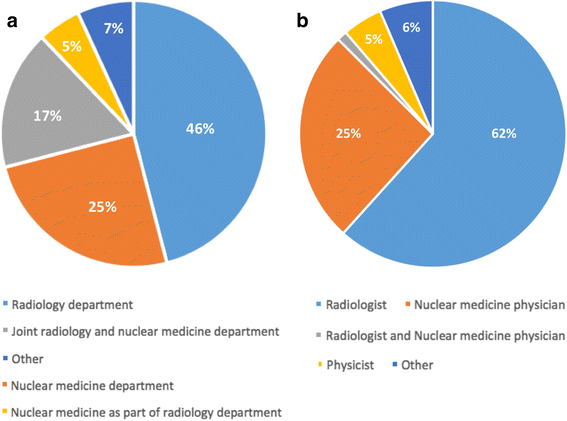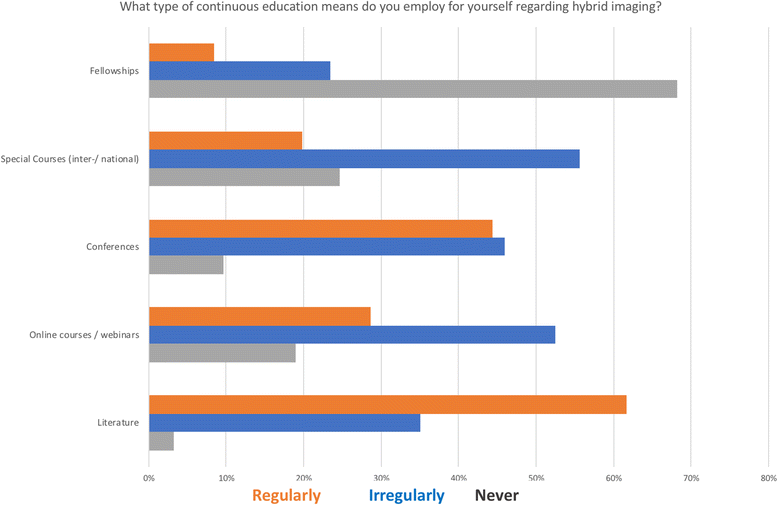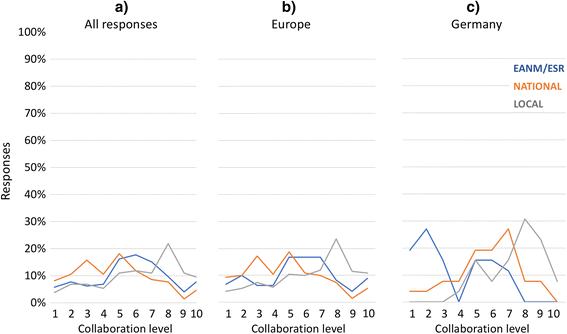An international survey on hybrid imaging: do technology advances preempt our training and education efforts?
- PMID: 29695290
- PMCID: PMC5922309
- DOI: 10.1186/s40644-018-0148-6
An international survey on hybrid imaging: do technology advances preempt our training and education efforts?
Abstract
Background: Hybrid PET/CT and PET/MRI are increasingly important technologies in the evaluation of malignancy and require cooperation between radiologists and specialists in molecular imaging. The aim of our study was to probe the mindsets of radiological and nuclear medicine professionals in regard to current hybrid imaging practice and to assess relevant training aspirations and perceived shortfalls, particularly amongst young professionals. In this context, we initiated an international survey on "Hybrid Imaging Training".
Methods: An online survey was prepared on-line and launched on October-2, 2016. It was composed of 17 multiple-choice and open questions regarding the professional background, a perspective on hybrid imaging training efforts and lessons to be learned from disparate craft groups. The survey ran for 2 weeks. We report total responses per category and individual free-text responses.
Results: In total, 248 responses were collected with a mean age of all responders of (41 ± 11) y. Overall, 36% were within the target age range of (20-35) y. Across all responders, the majority (72%) commented on there being too few hybrid imaging experts in their country, whereas only 1% said that there were too many. Three quarters of the responders were in favour of a curriculum allowing sub-specialisation in hybrid imaging. With respect to reporting of hybrid imaging, confidence increased with age. The average rating across all responders on the level of cooperation among the two specialties suggested a low overall level of satisfaction. However, the survey feedback indicated the local (on-site) cooperation being somewhat better than the perceived cooperation between the relevant associations on a European level.
Conclusion: We consider these results to represent an appropriate cross-section of professional opinions of imaging experts across different demographic and hierarchical levels. Collectively they provide evidence supporting a need to address current shortfalls in developing hybrid imaging expertise through national educational plans, and, thus, contribute to helping improve patient care.
Keywords: Conflict; Hybrid imaging; Profession; Specialization; Training and education.
Conflict of interest statement
Authors’ information
TB is co-founder of cmi-experts Ltd. and recipient of research support from Siemens Healthineers, and reports no conflict of interest with this study.
Ethics approval and consent to participate
NA
Competing interests
The authors declare that they have no competing interests.
Publisher’s Note
Springer Nature remains neutral with regard to jurisdictional claims in published maps and institutional affiliations.
Figures



References
-
- Brant W, Helms C. In: Fundamentals of diagnostic radiology. Brant W, Helms C, editors. Philadelphia: Lippincott Williams & Wilkins; 2007.
-
- Valk PE, et al. Positron emission tomography. Basic science and clinical practice. London: Springer; 2003.
-
- Wahl RL, et al. “Anatometabolic” tumor imaging: fusion of FDG PET with CT or MRI to localize foci of increased activity. J Nucl Med. 1993;34:1190–1197. - PubMed
MeSH terms
LinkOut - more resources
Full Text Sources
Other Literature Sources
Medical
Miscellaneous

